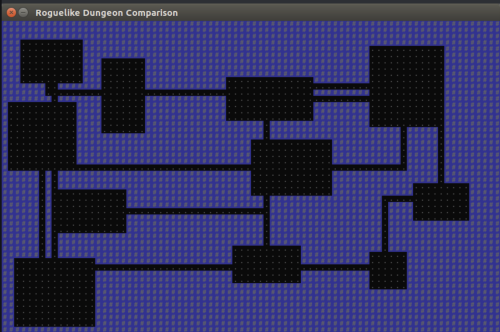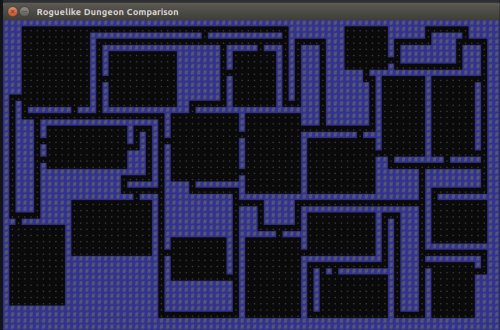
Keywords: relative neighborhood graph, room connection, room placement, connection graph, connection structure, dungeon generation, method, map, random, discard, maze, lead. Powered by TextRank.
There are a couple of different ways I've seen around the web for dungeon generation for rectangular rooms
It's safe to say you can breakdown dungeon generation into 2 base components
The placement can be done at a random fashion by generation of room at random x,y with random width and height. The coordinate selection can be normally distributed, the w/h generation can be normally distributed or have a gaussian distribution. It's likely that rooms generated this way will intersect. To deal with the you can either discard a room that overlaps with another room and continue generation until MAX_TRIES or the desired number of rooms has been reached. Another method is to space out rooms until non are overlapping and discard any rooms that have "fallen off" the edge of the map.
*method 1 - discard overlapping rooms*
for _ in 0...maxRooms {
let w = Int.random(in: minRoomSize...maxRoomSize)
let h = Int.random(in: minRoomSize...maxRoomSize)
let x = Int.random(in: 0..<cols - w)
let y = Int.random(in: 0..<rows - h)
let newRoom = Room(id: roomId, xy: XY(x: x, y: y), wh: WH(w: w, h: h))
roomId += 1
let failed = rooms.contains { newRoom.intersects(other: $0) }
if !failed {
renderer.drawBox(x: x, y: y, w: w, h: h)
rooms.append(newRoom)
}
}*method 2 - push out rooms until they don't intersect anymore*
var touching = true
while touching {
touching = false
for i in 0..<numRooms {
for j in (i+1)..<numRooms {
let a = cells[i]
let b = cells[j]
if a.intersects(other: b) {
touching = true
var dx = min(a.bottomRight.x - b.topLeft.x + padding, a.topLeft.x - b.bottomRight.x - padding)
var dy = min(a.bottomRight.y - b.topLeft.y + padding, a.topLeft.y - b.bottomRight.y - padding)
if abs(dx) < abs(dy) {
dy = 0
} else {
dx = 0
}
let dxa = Int(-dx / 2)
let dxb = dx + dxa
let dya = Int(-dy / 2)
let dyb = dy + dya
a.shift(dv: XY(x: dxa, y: dya))
b.shift(dv: XY(x: dxb, y: dyb))
}
}
}
}Connecting rooms can be done by connecting the current room with the one before it. You can have a X% chance of initiating the connection from the top of the room or the side of the room to add some flavor. This method guarantees that the dungeon is fully connected and usually as the number of rooms increase you get a cyclic connection structure which is more interesting than a non-cyclic structure. Using this method can lead to a direct connection from the start room to the end room. There are checks that could be implemented to mitigate this and the game mechanics may also give incentive to exploration to make this a non-issue. I call this the “n-1” connection/tunneler method.
if !failed {
renderer.drawBox(x: x, y: y, w: w, h: h)
let newX = newRoom.centerX
let newY = newRoom.centerY
if rooms.count != 0 {
let prevX = rooms.last!.centerX
let prevY = rooms.last!.centerY
if Int.random(in: 0...10) < 5 {
horTunnels.append((x0: prevX, x1: newX, y0: prevY))
vertTunnels.append((y0: prevY, y1: newY, x0: newX))
} else {
vertTunnels.append((y0: prevY, y1: newY, x0: prevX))
horTunnels.append((x0: prevX, x1: newX, y0: newY))
}
}
rooms.append(newRoom)
}The example code just stores the coordinates of the halls that are created and doesn't store the connection graph but that pretty trivial to implement but it's not needed as the level map provides this data after the tiles are laid on the map.
Another method of connecting the rooms is to use Relative Neighborhood Graphs. This is a subgraph of the Delauny Triangulation and tries to connect rooms that appear to be close and produce nice results. If this type of graph feels to strongly connected creating a MST for the rooms and then selectively adding X% percent of the RNG connections that may also yield good results.
The connecting halls them selves can either be straight, L shaped or meandering like a maze. Maze algorithms may lead to dead ends which may not be desirable but can easily be pruned (just remove any hall tile that surrounded by at least 3 empty tiles).
*a map generated by random intersecting prune placement and n-1 tunneling*

another map generated by the same algorithm as above (someone else wrote this, I saw their post on reddit in /r/roguelikedev but can't find it anymore so I can't properly credit them)

BSP made room placement with n-1 connection

Maze based tunnelling

741 words
Powered by TF-IDF/Cosine similarity
First published on 2020-06-03
Generated on 11 Aug 2025 at 12:23 PM
Mobile optimized version. Desktop version.